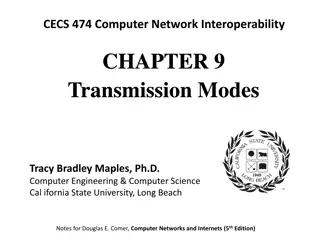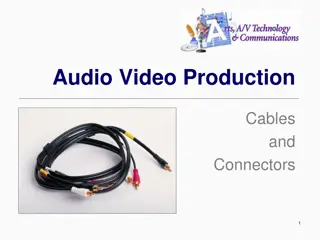Understanding Transmission Media and Twisted Pair Cables in Communication
Transmission media plays a crucial role in communication by transmitting data through electromagnetic signals. It is classified as guided media (using cables) and unguided media (waves through air, water, or vacuum). Twisted pair cables are a common type of guided media, consisting of insulated conductors twisted together to reduce crosstalk interference. Shielded Twisted Pair (STP) cables provide additional protection from external interferences. Understanding these concepts is essential for effective communication networks.
Download Presentation

Please find below an Image/Link to download the presentation.
The content on the website is provided AS IS for your information and personal use only. It may not be sold, licensed, or shared on other websites without obtaining consent from the author. Download presentation by click this link. If you encounter any issues during the download, it is possible that the publisher has removed the file from their server.
E N D
Presentation Transcript
Transmission Media Transmission media is a communication channel that carries the information from the sender to the receiver. Data is transmitted through the electromagnetic signals.
Contd Communication media has classified into two categories: Guided media: It includes cables. Unguided media: It includes waves through air, water or vacuum.
Twisted Pair Cable Insulation Conductor
Contd Insulation: It is any material that helps prevent or stop the passing of electricity,heat,or sound. Conductor: There are two conductors in twisted pair cable: That are generally made up of copper and each conductor has an insulation. One of the conductors is used to carry the signal and the other is used as a ground reference only.
Twisted Pair Cable Twisted-pair cable is a type of cabling that is used for telephone communications and most modern Ethernet networks. A pair of wires forms a circuit that can transmit data. The pairs are twisted to provide protection against crosstalk, the noise generated by adjacent pairs. As a voice grade medium(VGM)-> it is the basis for most internal office telephone wiring.It consists of two identical wires wrapped together in a double helix.
Contd In LAN applications will use a higher quality cable known as the data grade medium(DGM). Two things in common: The wires come in pairs. The pair of wires are twisted around each other.
Cross Talk The bleeding of a signal from one wire to another and which can corrupt signal and cause network errors. This form of signal interference is called Crosstalk.
Contd This type of cables comes with shielding of the individual parts of wires,which further protects from external interferences. It maximum segment length of 100 meters. The advantage of STP is that it offers greater protection from interference and crosstalk due to shielding. It is costlier than UTP. It requires proper grounding at both sides.
Contd Advantage Dis-advantage Advantage It is simple Because of high attenuation,it is incapable carrying a signal over long distance without the use of repeaters. It is easy to install and maintain Its low bandwidth capabilities make it unsuitable for broadband applications It is physically flexible Being thin in size, they are likely to break easily. It has a low weight It supports lower bandwidth as compared to other Medias. It can be easily connected It is very inexpensive
Contd Unshielded twisted pair (UTP) cables are widely used in the computer and telecommunications industry as Ethernet cables and telephone wires. In an UTP cable, conductors which form a single circuit are twisted around each other in order to cancel out electromagnetic interference (EMI) from external sources.
Contd Type Description Type Description CAT1 Voice-grade communications only;no data trasmisssion CAT5 Data grade transmission upto 1000Mbps CAT2 Data grade transmission upto 4 Mbps CAT6 Data grade transmission upto 10000Mbps CAT3 Data grade transmission upto 10 Mbps CAT7 Data grade transmission upto 10Gbps CAT4 Data grade transmission upto 16 Mbps CAT8 Data grade transmission upto 40 Gbps
Contd It consists of solid wire core surrounded by one or more foil or wire shields,each seperated by some kind of plastic insulator. The inner carries the signal,and the shield provides the ground. It has the high electrical properties and is suitable for high speed communication. It is less popular than twisted pair cable.
Contd It is widely used for television signals. The data transmission characteristics of coaxial cable are considerably better than those of twisted pair. It is the shared cable network.
Advantages The data transmission characteristics of coaxial cables are considerably better than those of twisted -pair cables. It can be used as the basis for a shared cable network. It can be used for the broadband transmission For eg: Several channels can be transmitted simultaneously. Offer higher bandwidths upto 400 MBPS
Dis-advantage Expensive compared to twisted pair cable. The coaxial cable are not compatible with twisted pair cable.
Types of Coaxial cables 1.Thicknet 2.Thinnet 1.Thicknet:(cable become thicker than thinnet) The thicknet coaxial cable segments(while joining nodes of the network)can be upto 500 metres long. 2.Thinnet(cable become thinnet than thicker) It has a maximum segment of 185 metres for eg:using this cables,nodes having maximum distance of 185 metres can be joined. They are:
Contd It consisted of thin strands of glass or glass like material which are so constructed that they carry light from a source at one end of the fiber to a detector at the other end. The light sources used are either light emitting diodes(LEDs) or laser diodes(LDs). The data to be transmitted is modulated onto the light beam using frequency modulation techniques.
Contd The signals can then be picked up at the receiving end and demodulated. The bandwidth of the medium is potentially very high. There are three pieces in fiber cable they are 1.Core 2.The Cladding 3.Protective coating
Three pieces Core: The glass or plastic through which the light travels. Cladding: it is the covering of the core that reflects light back to the core. Protective Coating: it protects the fiber cable from hostile environment.
Advantages It is highly used for harsh industrial environments. It guarantees secure transmission and has a very high transmission capacity. It can be used for broadband transmission where several channels. For eg:it handled in parallel and where it is also possible to mix data transmission channels with channels for telescope,graphics,TV and Sound.
Disadvantage They are the most expensive of all the cables. Connection losses are common problems. Light can reach the receiver out of phase. Fiber optic cables are more difficult to solder. Connecting either two fibers together or a light source to a fiber is a difficult process
Types of Fiber optic Cables Single node: That supports a segment length of upto 2 kms and bandwidth of upto 100Mbps. Multinode: It has a segment length o 100 kms and bandwidth of 2 Gbps.
Unguided media Microwave Radiowave Satellite (Satellite Microwave) Infrared Laser























